Cross-Cultural Marketing: Coca-Cola's Cuban Market Entry Strategy CW2
VerifiedAdded on 2023/01/16
|12
|3964
|63
Report
AI Summary
This report analyzes Coca-Cola's potential entry into the Cuban market, focusing on cross-cultural analysis and the adaptation of marketing strategies. It begins with an introduction to cross-cultural analysis, highlighting the importance of understanding cultural differences. The report then uses Hofstede's cultural dimensions (individualism vs. collectivism, masculinity vs. femininity, uncertainty avoidance) to compare the United States and Cuba, identifying key differences that will impact Coca-Cola's operations. It further explores the influence of social and cultural factors on the marketing mix (product, price, place, promotion, process, physical evidence, and people), emphasizing the need for adjustments to resonate with Cuban consumers. The report concludes by discussing market entry strategies and recommending the most suitable approach for Coca-Cola's successful expansion into Cuba, considering the unique cultural landscape and consumer behavior.
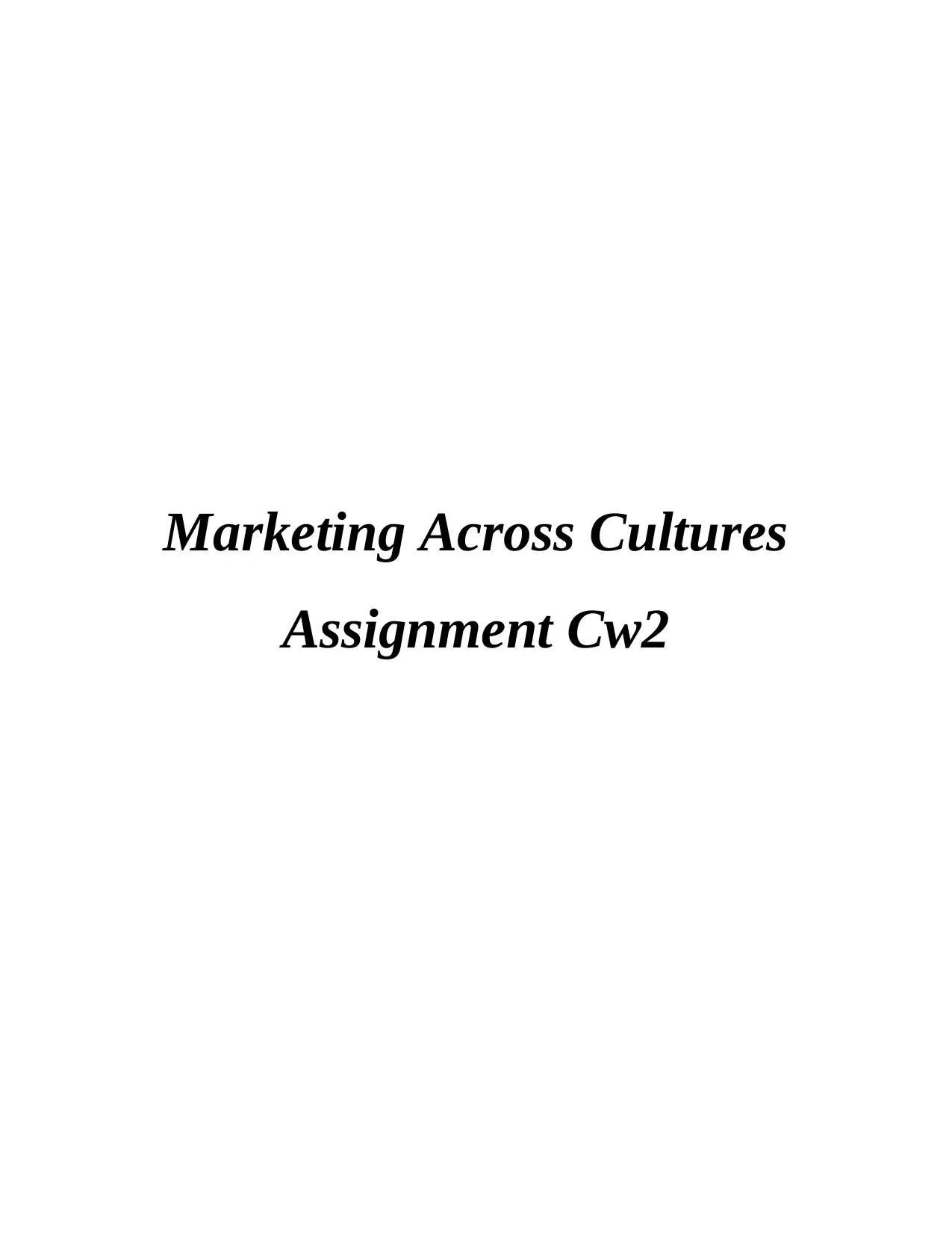
Marketing Across Cultures
Assignment Cw2
Assignment Cw2
Paraphrase This Document
Need a fresh take? Get an instant paraphrase of this document with our AI Paraphraser
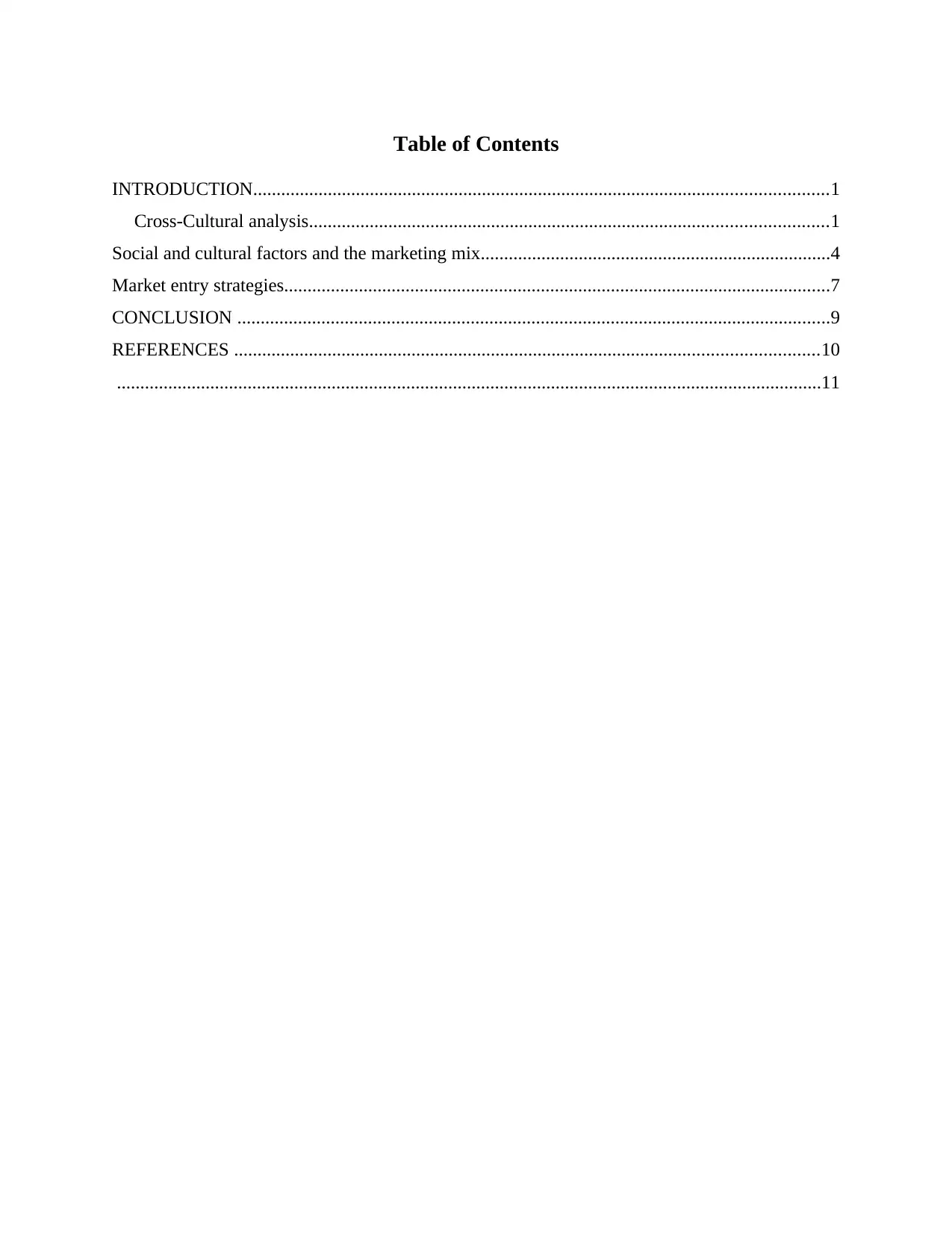
Table of Contents
INTRODUCTION...........................................................................................................................1
Cross-Cultural analysis...............................................................................................................1
Social and cultural factors and the marketing mix...........................................................................4
Market entry strategies.....................................................................................................................7
CONCLUSION ...............................................................................................................................9
REFERENCES .............................................................................................................................10
.......................................................................................................................................................11
INTRODUCTION...........................................................................................................................1
Cross-Cultural analysis...............................................................................................................1
Social and cultural factors and the marketing mix...........................................................................4
Market entry strategies.....................................................................................................................7
CONCLUSION ...............................................................................................................................9
REFERENCES .............................................................................................................................10
.......................................................................................................................................................11
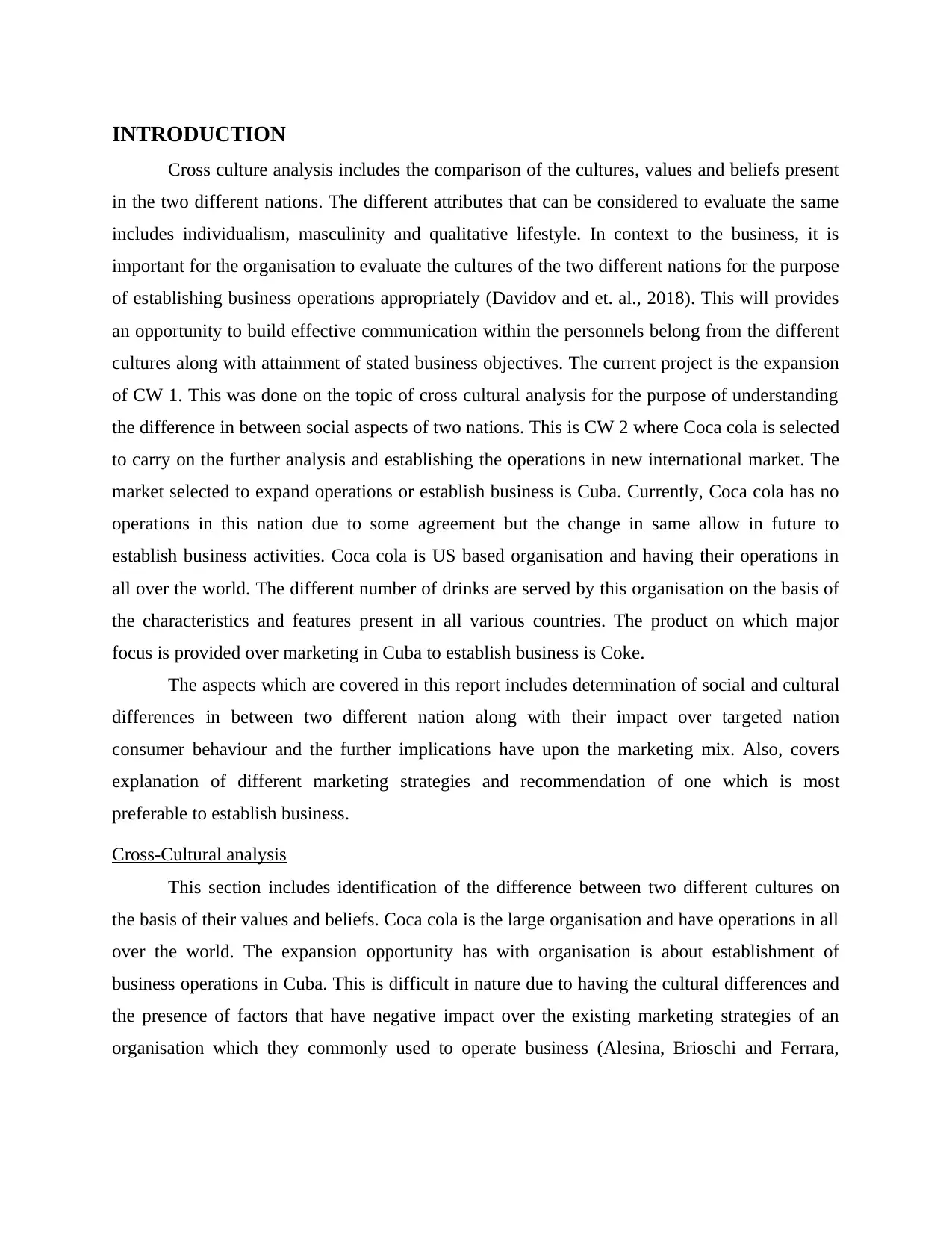
INTRODUCTION
Cross culture analysis includes the comparison of the cultures, values and beliefs present
in the two different nations. The different attributes that can be considered to evaluate the same
includes individualism, masculinity and qualitative lifestyle. In context to the business, it is
important for the organisation to evaluate the cultures of the two different nations for the purpose
of establishing business operations appropriately (Davidov and et. al., 2018). This will provides
an opportunity to build effective communication within the personnels belong from the different
cultures along with attainment of stated business objectives. The current project is the expansion
of CW 1. This was done on the topic of cross cultural analysis for the purpose of understanding
the difference in between social aspects of two nations. This is CW 2 where Coca cola is selected
to carry on the further analysis and establishing the operations in new international market. The
market selected to expand operations or establish business is Cuba. Currently, Coca cola has no
operations in this nation due to some agreement but the change in same allow in future to
establish business activities. Coca cola is US based organisation and having their operations in
all over the world. The different number of drinks are served by this organisation on the basis of
the characteristics and features present in all various countries. The product on which major
focus is provided over marketing in Cuba to establish business is Coke.
The aspects which are covered in this report includes determination of social and cultural
differences in between two different nation along with their impact over targeted nation
consumer behaviour and the further implications have upon the marketing mix. Also, covers
explanation of different marketing strategies and recommendation of one which is most
preferable to establish business.
Cross-Cultural analysis
This section includes identification of the difference between two different cultures on
the basis of their values and beliefs. Coca cola is the large organisation and have operations in all
over the world. The expansion opportunity has with organisation is about establishment of
business operations in Cuba. This is difficult in nature due to having the cultural differences and
the presence of factors that have negative impact over the existing marketing strategies of an
organisation which they commonly used to operate business (Alesina, Brioschi and Ferrara,
Cross culture analysis includes the comparison of the cultures, values and beliefs present
in the two different nations. The different attributes that can be considered to evaluate the same
includes individualism, masculinity and qualitative lifestyle. In context to the business, it is
important for the organisation to evaluate the cultures of the two different nations for the purpose
of establishing business operations appropriately (Davidov and et. al., 2018). This will provides
an opportunity to build effective communication within the personnels belong from the different
cultures along with attainment of stated business objectives. The current project is the expansion
of CW 1. This was done on the topic of cross cultural analysis for the purpose of understanding
the difference in between social aspects of two nations. This is CW 2 where Coca cola is selected
to carry on the further analysis and establishing the operations in new international market. The
market selected to expand operations or establish business is Cuba. Currently, Coca cola has no
operations in this nation due to some agreement but the change in same allow in future to
establish business activities. Coca cola is US based organisation and having their operations in
all over the world. The different number of drinks are served by this organisation on the basis of
the characteristics and features present in all various countries. The product on which major
focus is provided over marketing in Cuba to establish business is Coke.
The aspects which are covered in this report includes determination of social and cultural
differences in between two different nation along with their impact over targeted nation
consumer behaviour and the further implications have upon the marketing mix. Also, covers
explanation of different marketing strategies and recommendation of one which is most
preferable to establish business.
Cross-Cultural analysis
This section includes identification of the difference between two different cultures on
the basis of their values and beliefs. Coca cola is the large organisation and have operations in all
over the world. The expansion opportunity has with organisation is about establishment of
business operations in Cuba. This is difficult in nature due to having the cultural differences and
the presence of factors that have negative impact over the existing marketing strategies of an
organisation which they commonly used to operate business (Alesina, Brioschi and Ferrara,
⊘ This is a preview!⊘
Do you want full access?
Subscribe today to unlock all pages.

Trusted by 1+ million students worldwide
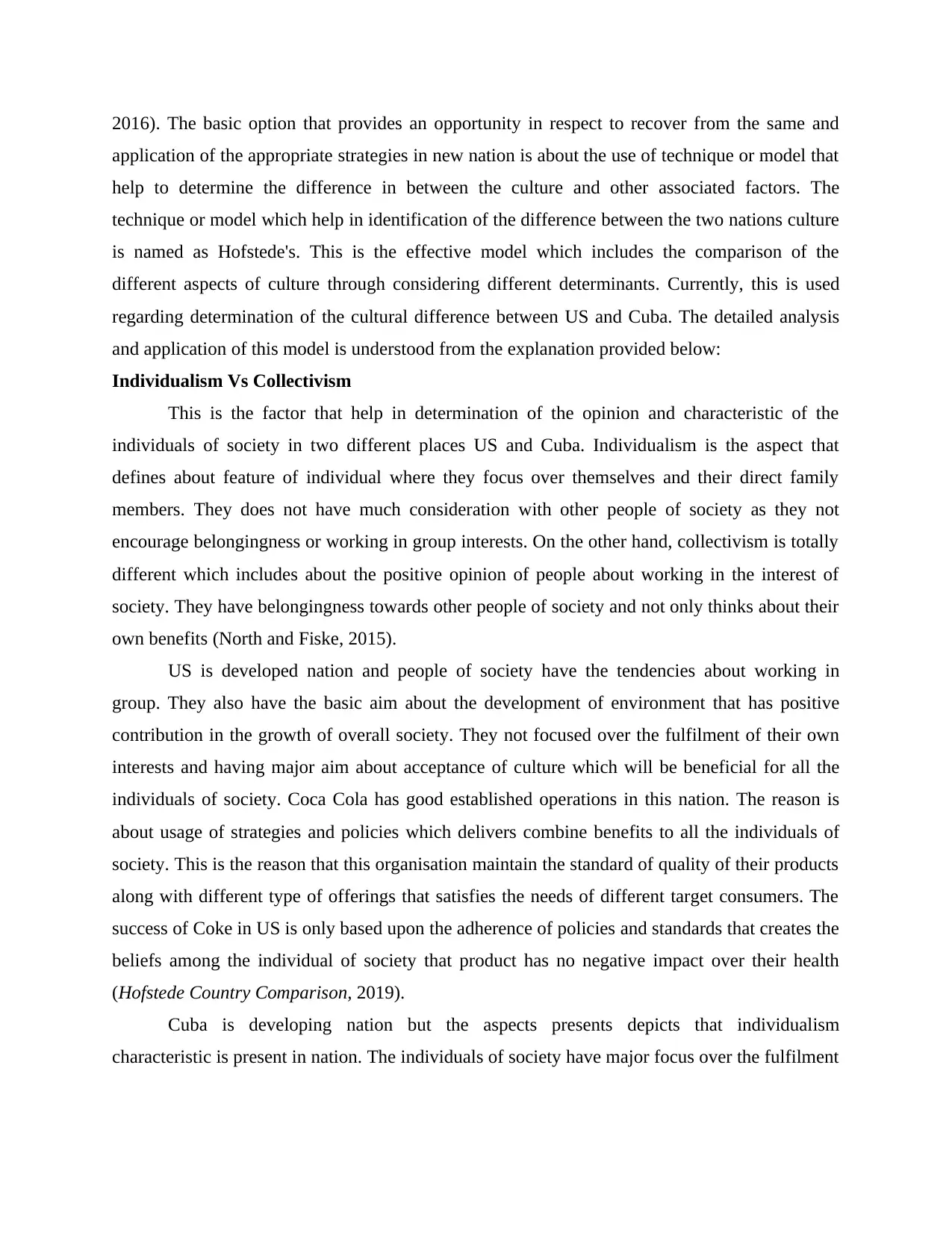
2016). The basic option that provides an opportunity in respect to recover from the same and
application of the appropriate strategies in new nation is about the use of technique or model that
help to determine the difference in between the culture and other associated factors. The
technique or model which help in identification of the difference between the two nations culture
is named as Hofstede's. This is the effective model which includes the comparison of the
different aspects of culture through considering different determinants. Currently, this is used
regarding determination of the cultural difference between US and Cuba. The detailed analysis
and application of this model is understood from the explanation provided below:
Individualism Vs Collectivism
This is the factor that help in determination of the opinion and characteristic of the
individuals of society in two different places US and Cuba. Individualism is the aspect that
defines about feature of individual where they focus over themselves and their direct family
members. They does not have much consideration with other people of society as they not
encourage belongingness or working in group interests. On the other hand, collectivism is totally
different which includes about the positive opinion of people about working in the interest of
society. They have belongingness towards other people of society and not only thinks about their
own benefits (North and Fiske, 2015).
US is developed nation and people of society have the tendencies about working in
group. They also have the basic aim about the development of environment that has positive
contribution in the growth of overall society. They not focused over the fulfilment of their own
interests and having major aim about acceptance of culture which will be beneficial for all the
individuals of society. Coca Cola has good established operations in this nation. The reason is
about usage of strategies and policies which delivers combine benefits to all the individuals of
society. This is the reason that this organisation maintain the standard of quality of their products
along with different type of offerings that satisfies the needs of different target consumers. The
success of Coke in US is only based upon the adherence of policies and standards that creates the
beliefs among the individual of society that product has no negative impact over their health
(Hofstede Country Comparison, 2019).
Cuba is developing nation but the aspects presents depicts that individualism
characteristic is present in nation. The individuals of society have major focus over the fulfilment
application of the appropriate strategies in new nation is about the use of technique or model that
help to determine the difference in between the culture and other associated factors. The
technique or model which help in identification of the difference between the two nations culture
is named as Hofstede's. This is the effective model which includes the comparison of the
different aspects of culture through considering different determinants. Currently, this is used
regarding determination of the cultural difference between US and Cuba. The detailed analysis
and application of this model is understood from the explanation provided below:
Individualism Vs Collectivism
This is the factor that help in determination of the opinion and characteristic of the
individuals of society in two different places US and Cuba. Individualism is the aspect that
defines about feature of individual where they focus over themselves and their direct family
members. They does not have much consideration with other people of society as they not
encourage belongingness or working in group interests. On the other hand, collectivism is totally
different which includes about the positive opinion of people about working in the interest of
society. They have belongingness towards other people of society and not only thinks about their
own benefits (North and Fiske, 2015).
US is developed nation and people of society have the tendencies about working in
group. They also have the basic aim about the development of environment that has positive
contribution in the growth of overall society. They not focused over the fulfilment of their own
interests and having major aim about acceptance of culture which will be beneficial for all the
individuals of society. Coca Cola has good established operations in this nation. The reason is
about usage of strategies and policies which delivers combine benefits to all the individuals of
society. This is the reason that this organisation maintain the standard of quality of their products
along with different type of offerings that satisfies the needs of different target consumers. The
success of Coke in US is only based upon the adherence of policies and standards that creates the
beliefs among the individual of society that product has no negative impact over their health
(Hofstede Country Comparison, 2019).
Cuba is developing nation but the aspects presents depicts that individualism
characteristic is present in nation. The individuals of society have major focus over the fulfilment
Paraphrase This Document
Need a fresh take? Get an instant paraphrase of this document with our AI Paraphraser
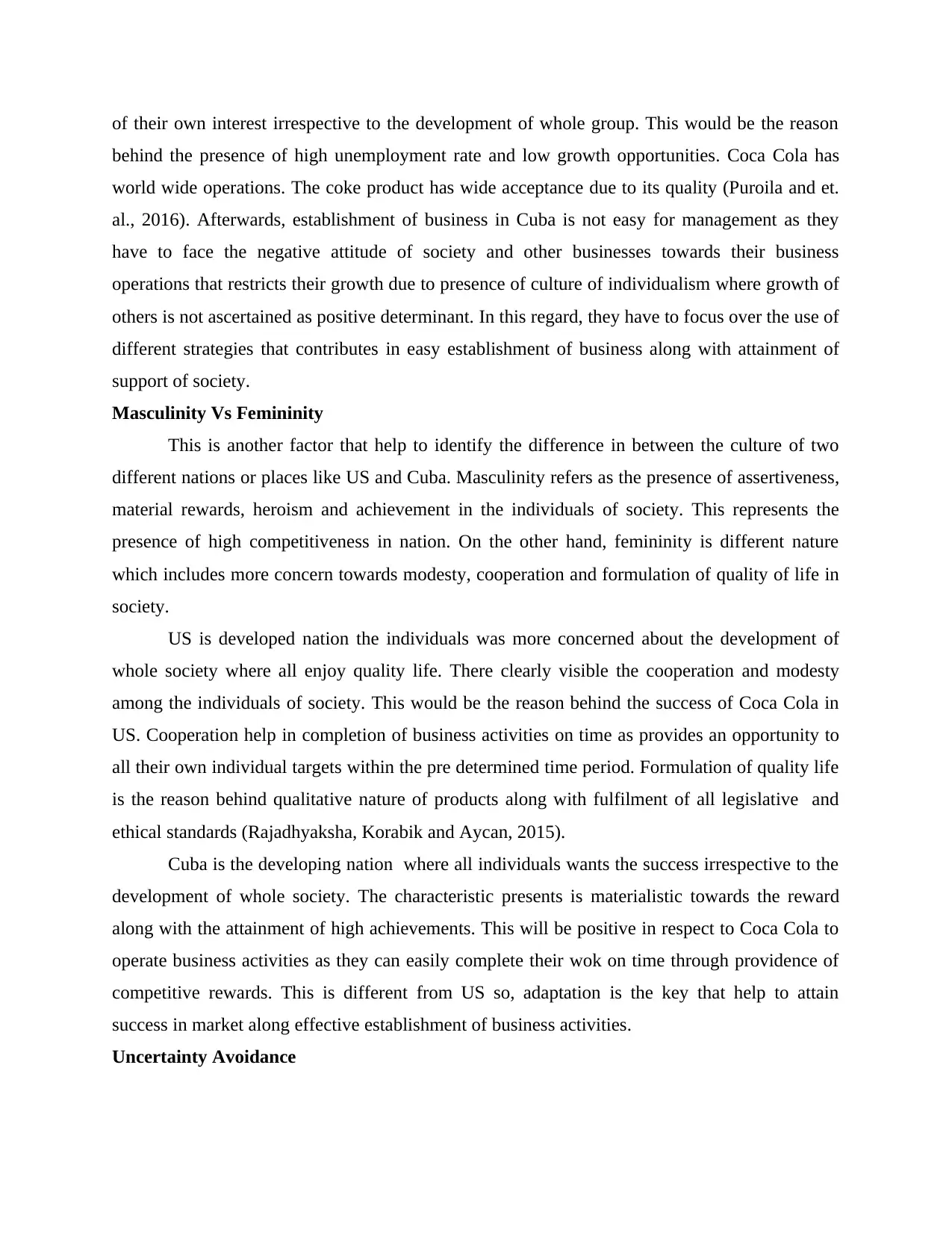
of their own interest irrespective to the development of whole group. This would be the reason
behind the presence of high unemployment rate and low growth opportunities. Coca Cola has
world wide operations. The coke product has wide acceptance due to its quality (Puroila and et.
al., 2016). Afterwards, establishment of business in Cuba is not easy for management as they
have to face the negative attitude of society and other businesses towards their business
operations that restricts their growth due to presence of culture of individualism where growth of
others is not ascertained as positive determinant. In this regard, they have to focus over the use of
different strategies that contributes in easy establishment of business along with attainment of
support of society.
Masculinity Vs Femininity
This is another factor that help to identify the difference in between the culture of two
different nations or places like US and Cuba. Masculinity refers as the presence of assertiveness,
material rewards, heroism and achievement in the individuals of society. This represents the
presence of high competitiveness in nation. On the other hand, femininity is different nature
which includes more concern towards modesty, cooperation and formulation of quality of life in
society.
US is developed nation the individuals was more concerned about the development of
whole society where all enjoy quality life. There clearly visible the cooperation and modesty
among the individuals of society. This would be the reason behind the success of Coca Cola in
US. Cooperation help in completion of business activities on time as provides an opportunity to
all their own individual targets within the pre determined time period. Formulation of quality life
is the reason behind qualitative nature of products along with fulfilment of all legislative and
ethical standards (Rajadhyaksha, Korabik and Aycan, 2015).
Cuba is the developing nation where all individuals wants the success irrespective to the
development of whole society. The characteristic presents is materialistic towards the reward
along with the attainment of high achievements. This will be positive in respect to Coca Cola to
operate business activities as they can easily complete their wok on time through providence of
competitive rewards. This is different from US so, adaptation is the key that help to attain
success in market along effective establishment of business activities.
Uncertainty Avoidance
behind the presence of high unemployment rate and low growth opportunities. Coca Cola has
world wide operations. The coke product has wide acceptance due to its quality (Puroila and et.
al., 2016). Afterwards, establishment of business in Cuba is not easy for management as they
have to face the negative attitude of society and other businesses towards their business
operations that restricts their growth due to presence of culture of individualism where growth of
others is not ascertained as positive determinant. In this regard, they have to focus over the use of
different strategies that contributes in easy establishment of business along with attainment of
support of society.
Masculinity Vs Femininity
This is another factor that help to identify the difference in between the culture of two
different nations or places like US and Cuba. Masculinity refers as the presence of assertiveness,
material rewards, heroism and achievement in the individuals of society. This represents the
presence of high competitiveness in nation. On the other hand, femininity is different nature
which includes more concern towards modesty, cooperation and formulation of quality of life in
society.
US is developed nation the individuals was more concerned about the development of
whole society where all enjoy quality life. There clearly visible the cooperation and modesty
among the individuals of society. This would be the reason behind the success of Coca Cola in
US. Cooperation help in completion of business activities on time as provides an opportunity to
all their own individual targets within the pre determined time period. Formulation of quality life
is the reason behind qualitative nature of products along with fulfilment of all legislative and
ethical standards (Rajadhyaksha, Korabik and Aycan, 2015).
Cuba is the developing nation where all individuals wants the success irrespective to the
development of whole society. The characteristic presents is materialistic towards the reward
along with the attainment of high achievements. This will be positive in respect to Coca Cola to
operate business activities as they can easily complete their wok on time through providence of
competitive rewards. This is different from US so, adaptation is the key that help to attain
success in market along effective establishment of business activities.
Uncertainty Avoidance
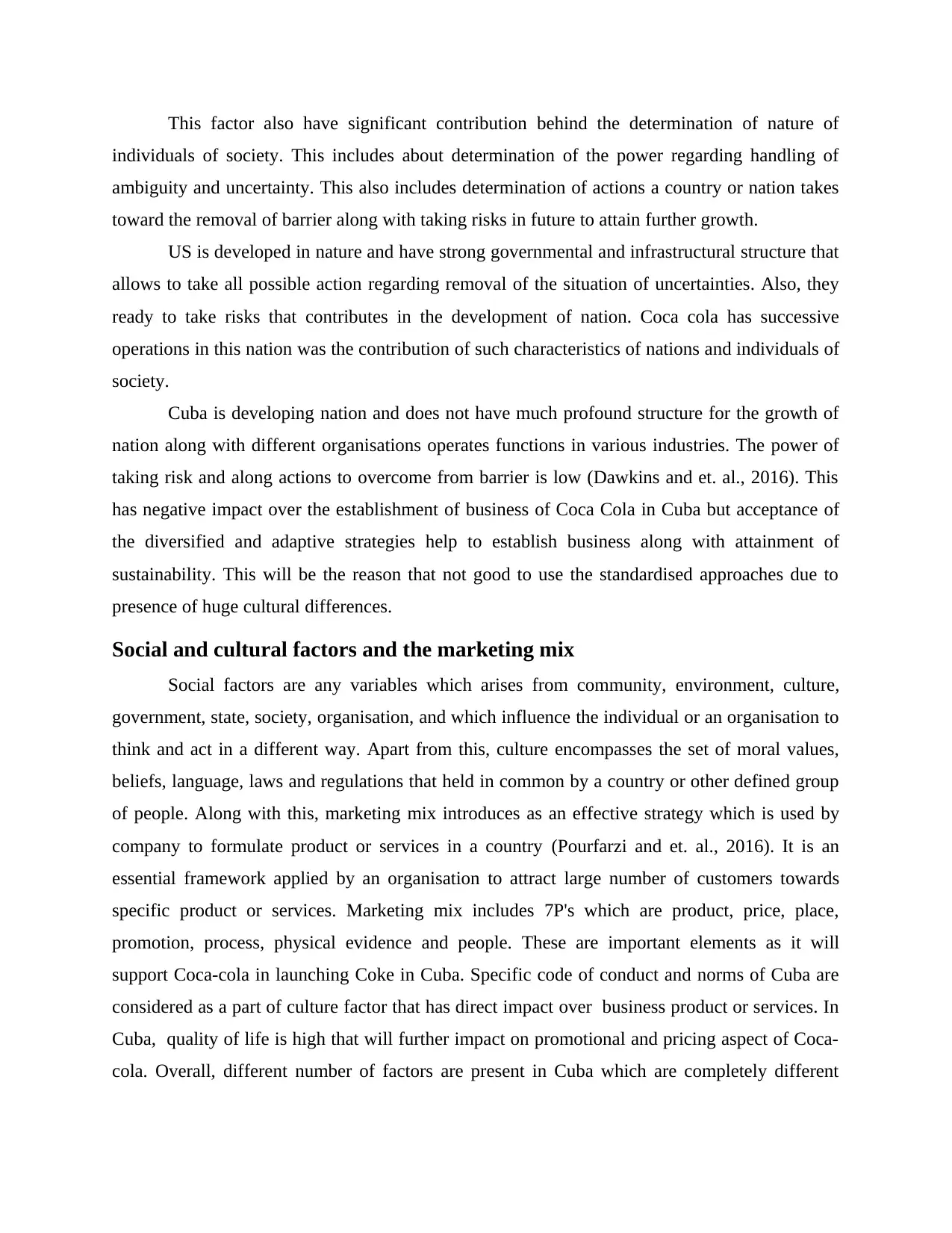
This factor also have significant contribution behind the determination of nature of
individuals of society. This includes about determination of the power regarding handling of
ambiguity and uncertainty. This also includes determination of actions a country or nation takes
toward the removal of barrier along with taking risks in future to attain further growth.
US is developed in nature and have strong governmental and infrastructural structure that
allows to take all possible action regarding removal of the situation of uncertainties. Also, they
ready to take risks that contributes in the development of nation. Coca cola has successive
operations in this nation was the contribution of such characteristics of nations and individuals of
society.
Cuba is developing nation and does not have much profound structure for the growth of
nation along with different organisations operates functions in various industries. The power of
taking risk and along actions to overcome from barrier is low (Dawkins and et. al., 2016). This
has negative impact over the establishment of business of Coca Cola in Cuba but acceptance of
the diversified and adaptive strategies help to establish business along with attainment of
sustainability. This will be the reason that not good to use the standardised approaches due to
presence of huge cultural differences.
Social and cultural factors and the marketing mix
Social factors are any variables which arises from community, environment, culture,
government, state, society, organisation, and which influence the individual or an organisation to
think and act in a different way. Apart from this, culture encompasses the set of moral values,
beliefs, language, laws and regulations that held in common by a country or other defined group
of people. Along with this, marketing mix introduces as an effective strategy which is used by
company to formulate product or services in a country (Pourfarzi and et. al., 2016). It is an
essential framework applied by an organisation to attract large number of customers towards
specific product or services. Marketing mix includes 7P's which are product, price, place,
promotion, process, physical evidence and people. These are important elements as it will
support Coca-cola in launching Coke in Cuba. Specific code of conduct and norms of Cuba are
considered as a part of culture factor that has direct impact over business product or services. In
Cuba, quality of life is high that will further impact on promotional and pricing aspect of Coca-
cola. Overall, different number of factors are present in Cuba which are completely different
individuals of society. This includes about determination of the power regarding handling of
ambiguity and uncertainty. This also includes determination of actions a country or nation takes
toward the removal of barrier along with taking risks in future to attain further growth.
US is developed in nature and have strong governmental and infrastructural structure that
allows to take all possible action regarding removal of the situation of uncertainties. Also, they
ready to take risks that contributes in the development of nation. Coca cola has successive
operations in this nation was the contribution of such characteristics of nations and individuals of
society.
Cuba is developing nation and does not have much profound structure for the growth of
nation along with different organisations operates functions in various industries. The power of
taking risk and along actions to overcome from barrier is low (Dawkins and et. al., 2016). This
has negative impact over the establishment of business of Coca Cola in Cuba but acceptance of
the diversified and adaptive strategies help to establish business along with attainment of
sustainability. This will be the reason that not good to use the standardised approaches due to
presence of huge cultural differences.
Social and cultural factors and the marketing mix
Social factors are any variables which arises from community, environment, culture,
government, state, society, organisation, and which influence the individual or an organisation to
think and act in a different way. Apart from this, culture encompasses the set of moral values,
beliefs, language, laws and regulations that held in common by a country or other defined group
of people. Along with this, marketing mix introduces as an effective strategy which is used by
company to formulate product or services in a country (Pourfarzi and et. al., 2016). It is an
essential framework applied by an organisation to attract large number of customers towards
specific product or services. Marketing mix includes 7P's which are product, price, place,
promotion, process, physical evidence and people. These are important elements as it will
support Coca-cola in launching Coke in Cuba. Specific code of conduct and norms of Cuba are
considered as a part of culture factor that has direct impact over business product or services. In
Cuba, quality of life is high that will further impact on promotional and pricing aspect of Coca-
cola. Overall, different number of factors are present in Cuba which are completely different
⊘ This is a preview!⊘
Do you want full access?
Subscribe today to unlock all pages.

Trusted by 1+ million students worldwide
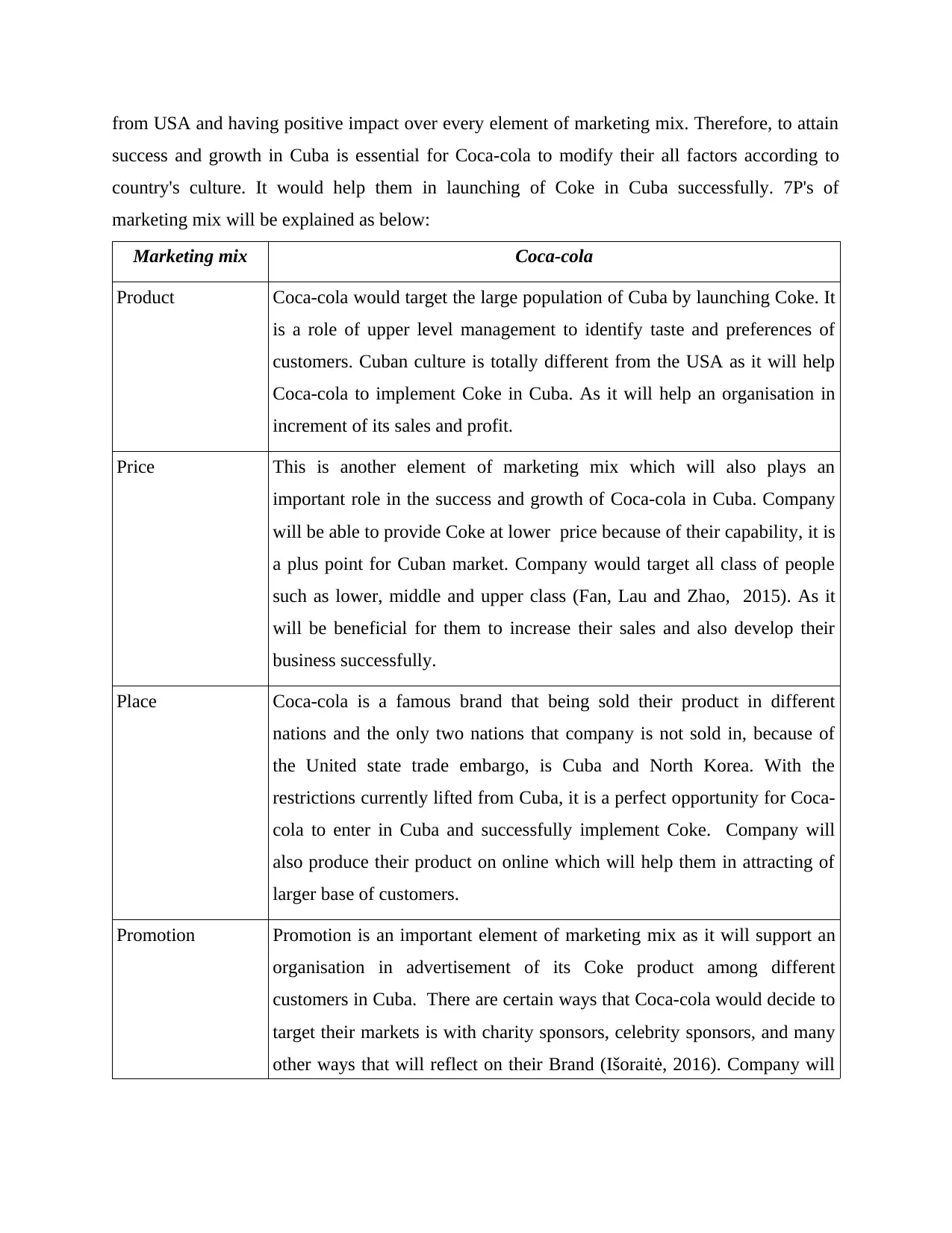
from USA and having positive impact over every element of marketing mix. Therefore, to attain
success and growth in Cuba is essential for Coca-cola to modify their all factors according to
country's culture. It would help them in launching of Coke in Cuba successfully. 7P's of
marketing mix will be explained as below:
Marketing mix Coca-cola
Product Coca-cola would target the large population of Cuba by launching Coke. It
is a role of upper level management to identify taste and preferences of
customers. Cuban culture is totally different from the USA as it will help
Coca-cola to implement Coke in Cuba. As it will help an organisation in
increment of its sales and profit.
Price This is another element of marketing mix which will also plays an
important role in the success and growth of Coca-cola in Cuba. Company
will be able to provide Coke at lower price because of their capability, it is
a plus point for Cuban market. Company would target all class of people
such as lower, middle and upper class (Fan, Lau and Zhao, 2015). As it
will be beneficial for them to increase their sales and also develop their
business successfully.
Place Coca-cola is a famous brand that being sold their product in different
nations and the only two nations that company is not sold in, because of
the United state trade embargo, is Cuba and North Korea. With the
restrictions currently lifted from Cuba, it is a perfect opportunity for Coca-
cola to enter in Cuba and successfully implement Coke. Company will
also produce their product on online which will help them in attracting of
larger base of customers.
Promotion Promotion is an important element of marketing mix as it will support an
organisation in advertisement of its Coke product among different
customers in Cuba. There are certain ways that Coca-cola would decide to
target their markets is with charity sponsors, celebrity sponsors, and many
other ways that will reflect on their Brand (Išoraitė, 2016). Company will
success and growth in Cuba is essential for Coca-cola to modify their all factors according to
country's culture. It would help them in launching of Coke in Cuba successfully. 7P's of
marketing mix will be explained as below:
Marketing mix Coca-cola
Product Coca-cola would target the large population of Cuba by launching Coke. It
is a role of upper level management to identify taste and preferences of
customers. Cuban culture is totally different from the USA as it will help
Coca-cola to implement Coke in Cuba. As it will help an organisation in
increment of its sales and profit.
Price This is another element of marketing mix which will also plays an
important role in the success and growth of Coca-cola in Cuba. Company
will be able to provide Coke at lower price because of their capability, it is
a plus point for Cuban market. Company would target all class of people
such as lower, middle and upper class (Fan, Lau and Zhao, 2015). As it
will be beneficial for them to increase their sales and also develop their
business successfully.
Place Coca-cola is a famous brand that being sold their product in different
nations and the only two nations that company is not sold in, because of
the United state trade embargo, is Cuba and North Korea. With the
restrictions currently lifted from Cuba, it is a perfect opportunity for Coca-
cola to enter in Cuba and successfully implement Coke. Company will
also produce their product on online which will help them in attracting of
larger base of customers.
Promotion Promotion is an important element of marketing mix as it will support an
organisation in advertisement of its Coke product among different
customers in Cuba. There are certain ways that Coca-cola would decide to
target their markets is with charity sponsors, celebrity sponsors, and many
other ways that will reflect on their Brand (Išoraitė, 2016). Company will
Paraphrase This Document
Need a fresh take? Get an instant paraphrase of this document with our AI Paraphraser
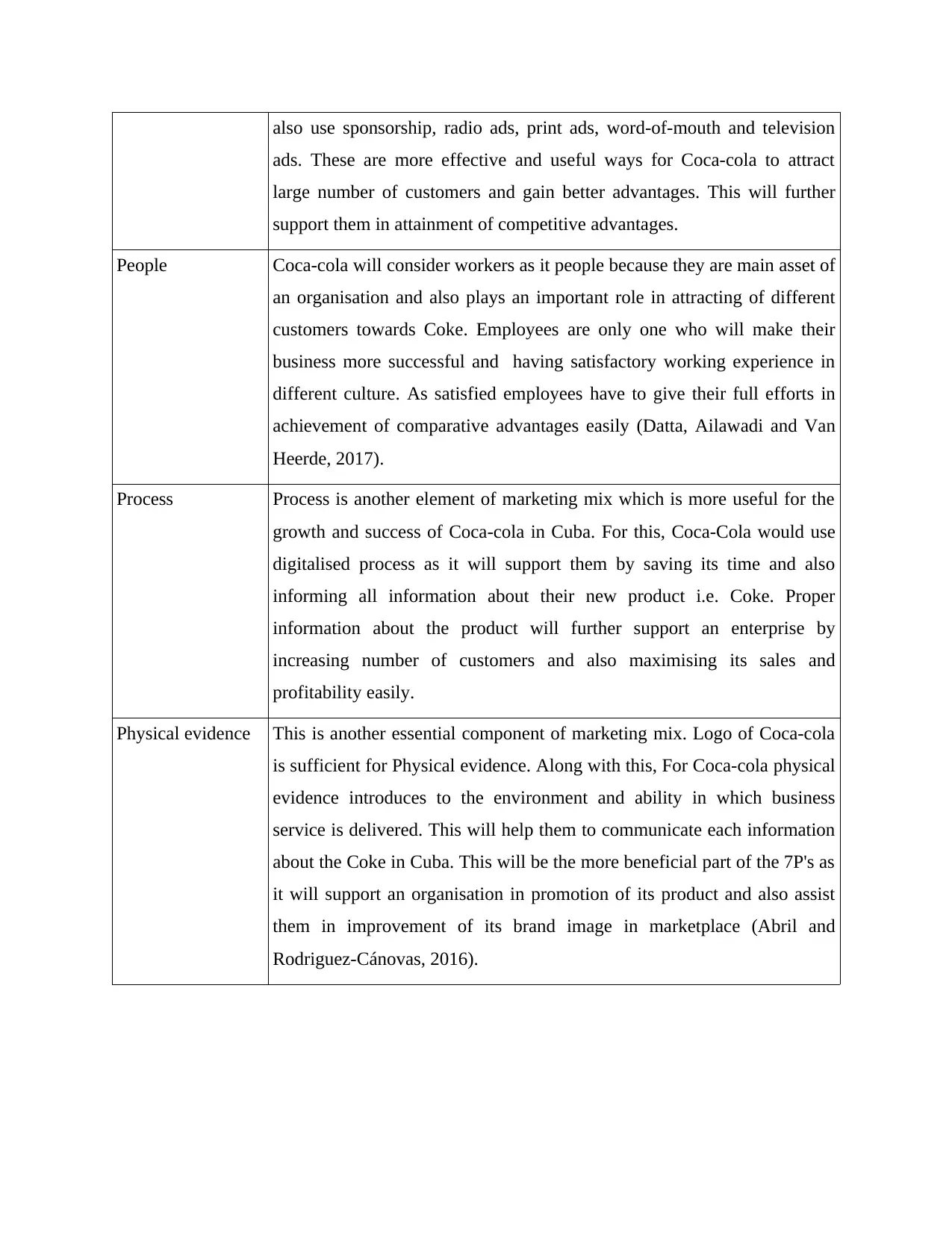
also use sponsorship, radio ads, print ads, word-of-mouth and television
ads. These are more effective and useful ways for Coca-cola to attract
large number of customers and gain better advantages. This will further
support them in attainment of competitive advantages.
People Coca-cola will consider workers as it people because they are main asset of
an organisation and also plays an important role in attracting of different
customers towards Coke. Employees are only one who will make their
business more successful and having satisfactory working experience in
different culture. As satisfied employees have to give their full efforts in
achievement of comparative advantages easily (Datta, Ailawadi and Van
Heerde, 2017).
Process Process is another element of marketing mix which is more useful for the
growth and success of Coca-cola in Cuba. For this, Coca-Cola would use
digitalised process as it will support them by saving its time and also
informing all information about their new product i.e. Coke. Proper
information about the product will further support an enterprise by
increasing number of customers and also maximising its sales and
profitability easily.
Physical evidence This is another essential component of marketing mix. Logo of Coca-cola
is sufficient for Physical evidence. Along with this, For Coca-cola physical
evidence introduces to the environment and ability in which business
service is delivered. This will help them to communicate each information
about the Coke in Cuba. This will be the more beneficial part of the 7P's as
it will support an organisation in promotion of its product and also assist
them in improvement of its brand image in marketplace (Abril and
Rodriguez-Cánovas, 2016).
ads. These are more effective and useful ways for Coca-cola to attract
large number of customers and gain better advantages. This will further
support them in attainment of competitive advantages.
People Coca-cola will consider workers as it people because they are main asset of
an organisation and also plays an important role in attracting of different
customers towards Coke. Employees are only one who will make their
business more successful and having satisfactory working experience in
different culture. As satisfied employees have to give their full efforts in
achievement of comparative advantages easily (Datta, Ailawadi and Van
Heerde, 2017).
Process Process is another element of marketing mix which is more useful for the
growth and success of Coca-cola in Cuba. For this, Coca-Cola would use
digitalised process as it will support them by saving its time and also
informing all information about their new product i.e. Coke. Proper
information about the product will further support an enterprise by
increasing number of customers and also maximising its sales and
profitability easily.
Physical evidence This is another essential component of marketing mix. Logo of Coca-cola
is sufficient for Physical evidence. Along with this, For Coca-cola physical
evidence introduces to the environment and ability in which business
service is delivered. This will help them to communicate each information
about the Coke in Cuba. This will be the more beneficial part of the 7P's as
it will support an organisation in promotion of its product and also assist
them in improvement of its brand image in marketplace (Abril and
Rodriguez-Cánovas, 2016).
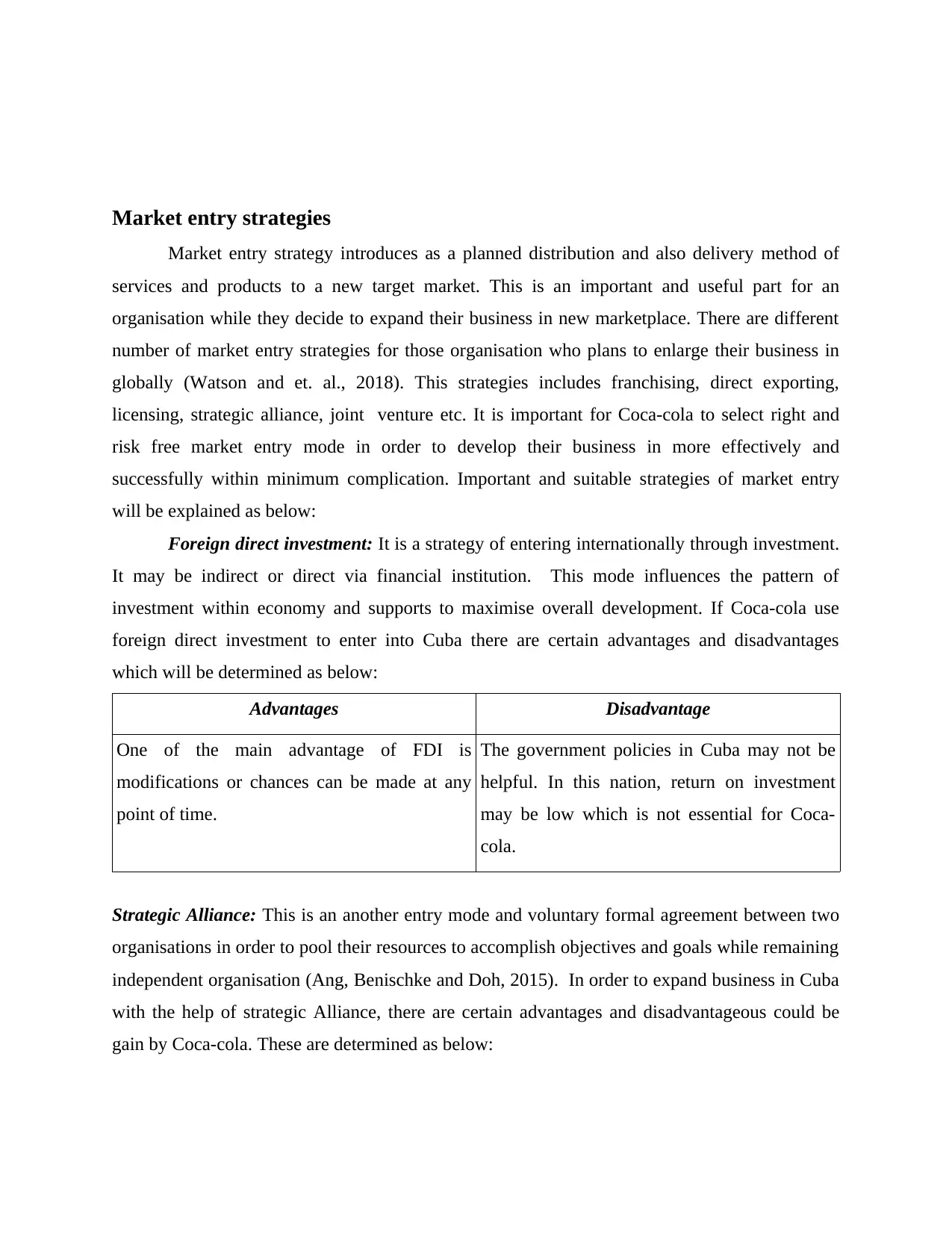
Market entry strategies
Market entry strategy introduces as a planned distribution and also delivery method of
services and products to a new target market. This is an important and useful part for an
organisation while they decide to expand their business in new marketplace. There are different
number of market entry strategies for those organisation who plans to enlarge their business in
globally (Watson and et. al., 2018). This strategies includes franchising, direct exporting,
licensing, strategic alliance, joint venture etc. It is important for Coca-cola to select right and
risk free market entry mode in order to develop their business in more effectively and
successfully within minimum complication. Important and suitable strategies of market entry
will be explained as below:
Foreign direct investment: It is a strategy of entering internationally through investment.
It may be indirect or direct via financial institution. This mode influences the pattern of
investment within economy and supports to maximise overall development. If Coca-cola use
foreign direct investment to enter into Cuba there are certain advantages and disadvantages
which will be determined as below:
Advantages Disadvantage
One of the main advantage of FDI is
modifications or chances can be made at any
point of time.
The government policies in Cuba may not be
helpful. In this nation, return on investment
may be low which is not essential for Coca-
cola.
Strategic Alliance: This is an another entry mode and voluntary formal agreement between two
organisations in order to pool their resources to accomplish objectives and goals while remaining
independent organisation (Ang, Benischke and Doh, 2015). In order to expand business in Cuba
with the help of strategic Alliance, there are certain advantages and disadvantageous could be
gain by Coca-cola. These are determined as below:
Market entry strategy introduces as a planned distribution and also delivery method of
services and products to a new target market. This is an important and useful part for an
organisation while they decide to expand their business in new marketplace. There are different
number of market entry strategies for those organisation who plans to enlarge their business in
globally (Watson and et. al., 2018). This strategies includes franchising, direct exporting,
licensing, strategic alliance, joint venture etc. It is important for Coca-cola to select right and
risk free market entry mode in order to develop their business in more effectively and
successfully within minimum complication. Important and suitable strategies of market entry
will be explained as below:
Foreign direct investment: It is a strategy of entering internationally through investment.
It may be indirect or direct via financial institution. This mode influences the pattern of
investment within economy and supports to maximise overall development. If Coca-cola use
foreign direct investment to enter into Cuba there are certain advantages and disadvantages
which will be determined as below:
Advantages Disadvantage
One of the main advantage of FDI is
modifications or chances can be made at any
point of time.
The government policies in Cuba may not be
helpful. In this nation, return on investment
may be low which is not essential for Coca-
cola.
Strategic Alliance: This is an another entry mode and voluntary formal agreement between two
organisations in order to pool their resources to accomplish objectives and goals while remaining
independent organisation (Ang, Benischke and Doh, 2015). In order to expand business in Cuba
with the help of strategic Alliance, there are certain advantages and disadvantageous could be
gain by Coca-cola. These are determined as below:
⊘ This is a preview!⊘
Do you want full access?
Subscribe today to unlock all pages.

Trusted by 1+ million students worldwide
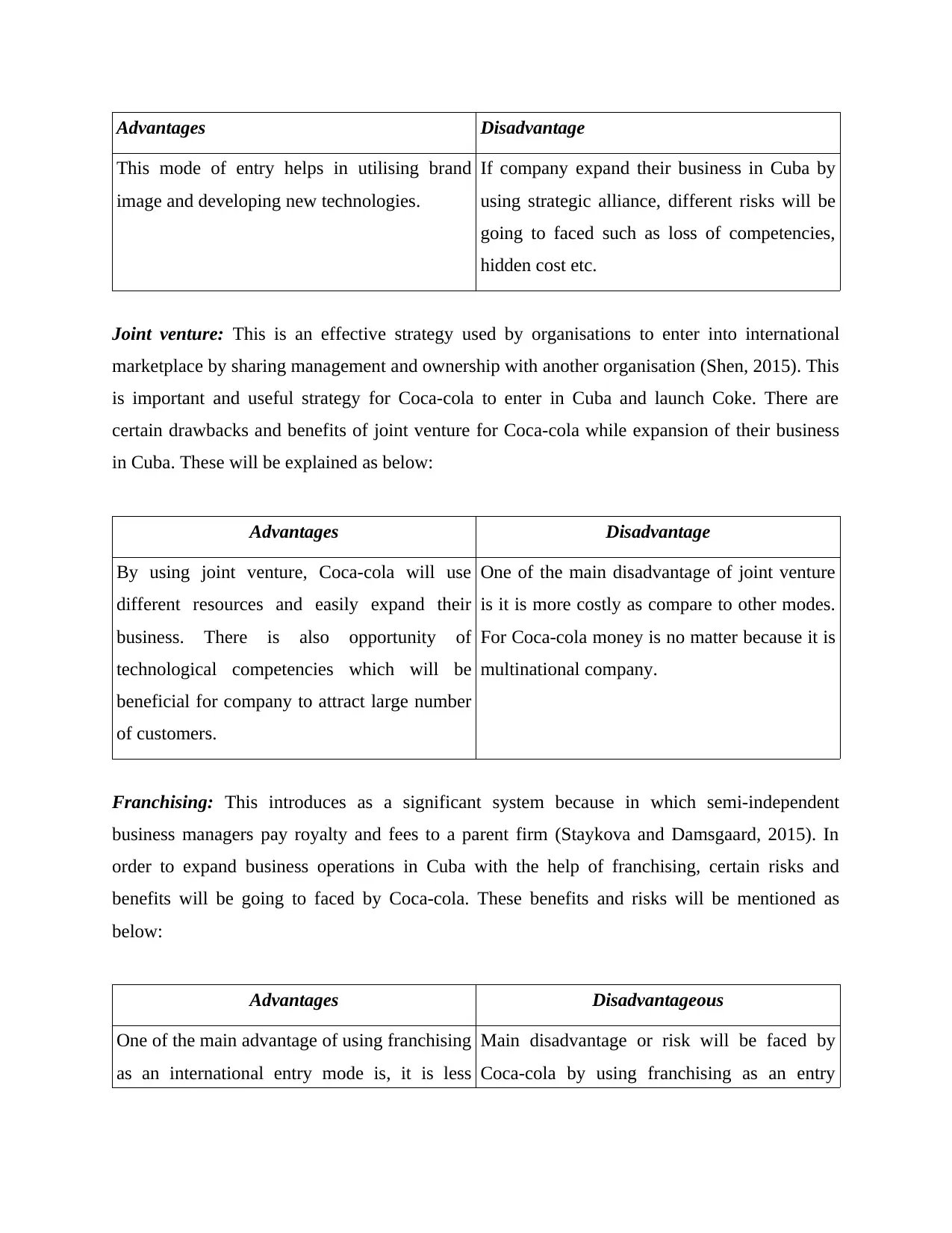
Advantages Disadvantage
This mode of entry helps in utilising brand
image and developing new technologies.
If company expand their business in Cuba by
using strategic alliance, different risks will be
going to faced such as loss of competencies,
hidden cost etc.
Joint venture: This is an effective strategy used by organisations to enter into international
marketplace by sharing management and ownership with another organisation (Shen, 2015). This
is important and useful strategy for Coca-cola to enter in Cuba and launch Coke. There are
certain drawbacks and benefits of joint venture for Coca-cola while expansion of their business
in Cuba. These will be explained as below:
Advantages Disadvantage
By using joint venture, Coca-cola will use
different resources and easily expand their
business. There is also opportunity of
technological competencies which will be
beneficial for company to attract large number
of customers.
One of the main disadvantage of joint venture
is it is more costly as compare to other modes.
For Coca-cola money is no matter because it is
multinational company.
Franchising: This introduces as a significant system because in which semi-independent
business managers pay royalty and fees to a parent firm (Staykova and Damsgaard, 2015). In
order to expand business operations in Cuba with the help of franchising, certain risks and
benefits will be going to faced by Coca-cola. These benefits and risks will be mentioned as
below:
Advantages Disadvantageous
One of the main advantage of using franchising
as an international entry mode is, it is less
Main disadvantage or risk will be faced by
Coca-cola by using franchising as an entry
This mode of entry helps in utilising brand
image and developing new technologies.
If company expand their business in Cuba by
using strategic alliance, different risks will be
going to faced such as loss of competencies,
hidden cost etc.
Joint venture: This is an effective strategy used by organisations to enter into international
marketplace by sharing management and ownership with another organisation (Shen, 2015). This
is important and useful strategy for Coca-cola to enter in Cuba and launch Coke. There are
certain drawbacks and benefits of joint venture for Coca-cola while expansion of their business
in Cuba. These will be explained as below:
Advantages Disadvantage
By using joint venture, Coca-cola will use
different resources and easily expand their
business. There is also opportunity of
technological competencies which will be
beneficial for company to attract large number
of customers.
One of the main disadvantage of joint venture
is it is more costly as compare to other modes.
For Coca-cola money is no matter because it is
multinational company.
Franchising: This introduces as a significant system because in which semi-independent
business managers pay royalty and fees to a parent firm (Staykova and Damsgaard, 2015). In
order to expand business operations in Cuba with the help of franchising, certain risks and
benefits will be going to faced by Coca-cola. These benefits and risks will be mentioned as
below:
Advantages Disadvantageous
One of the main advantage of using franchising
as an international entry mode is, it is less
Main disadvantage or risk will be faced by
Coca-cola by using franchising as an entry
Paraphrase This Document
Need a fresh take? Get an instant paraphrase of this document with our AI Paraphraser
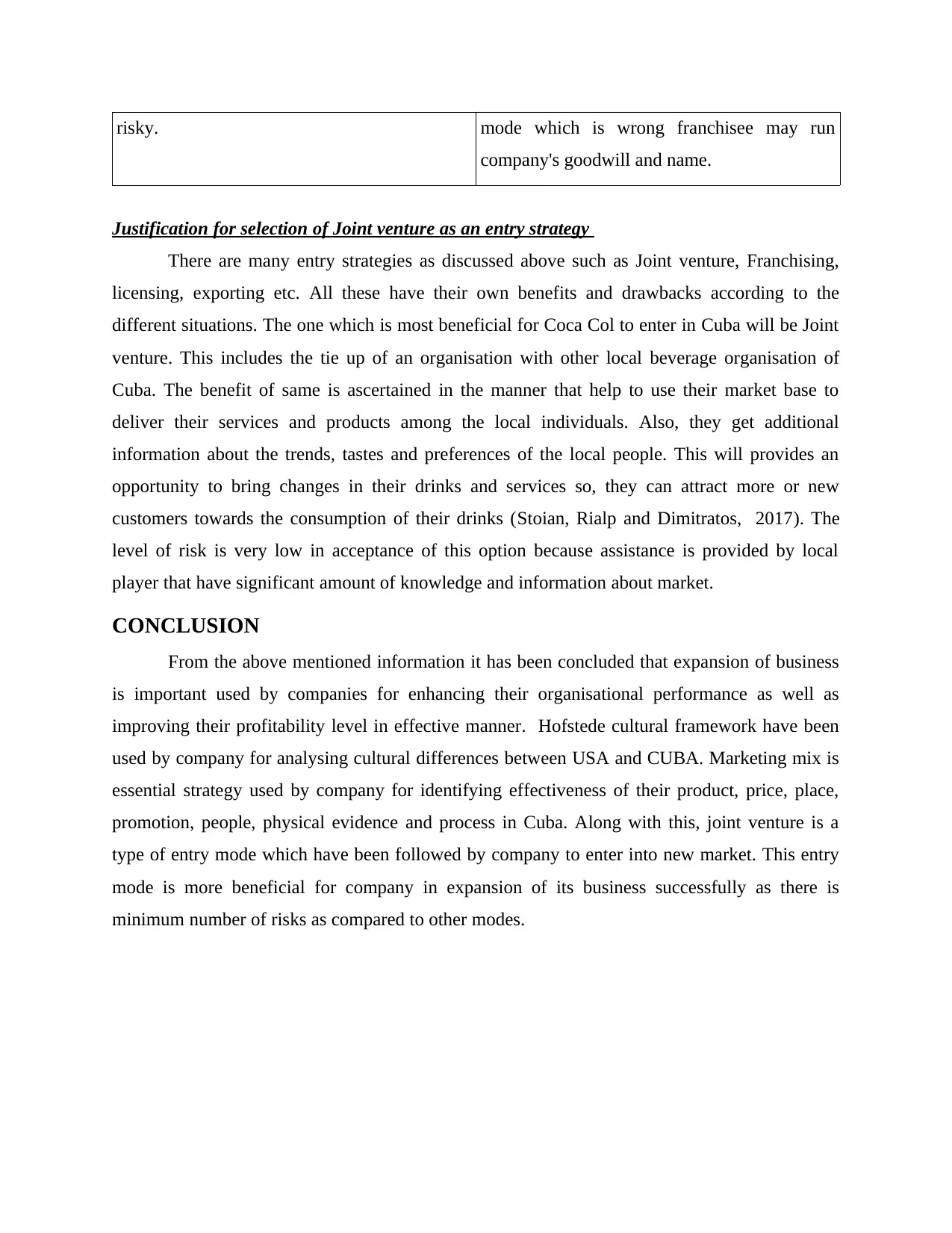
risky. mode which is wrong franchisee may run
company's goodwill and name.
Justification for selection of Joint venture as an entry strategy
There are many entry strategies as discussed above such as Joint venture, Franchising,
licensing, exporting etc. All these have their own benefits and drawbacks according to the
different situations. The one which is most beneficial for Coca Col to enter in Cuba will be Joint
venture. This includes the tie up of an organisation with other local beverage organisation of
Cuba. The benefit of same is ascertained in the manner that help to use their market base to
deliver their services and products among the local individuals. Also, they get additional
information about the trends, tastes and preferences of the local people. This will provides an
opportunity to bring changes in their drinks and services so, they can attract more or new
customers towards the consumption of their drinks (Stoian, Rialp and Dimitratos, 2017). The
level of risk is very low in acceptance of this option because assistance is provided by local
player that have significant amount of knowledge and information about market.
CONCLUSION
From the above mentioned information it has been concluded that expansion of business
is important used by companies for enhancing their organisational performance as well as
improving their profitability level in effective manner. Hofstede cultural framework have been
used by company for analysing cultural differences between USA and CUBA. Marketing mix is
essential strategy used by company for identifying effectiveness of their product, price, place,
promotion, people, physical evidence and process in Cuba. Along with this, joint venture is a
type of entry mode which have been followed by company to enter into new market. This entry
mode is more beneficial for company in expansion of its business successfully as there is
minimum number of risks as compared to other modes.
company's goodwill and name.
Justification for selection of Joint venture as an entry strategy
There are many entry strategies as discussed above such as Joint venture, Franchising,
licensing, exporting etc. All these have their own benefits and drawbacks according to the
different situations. The one which is most beneficial for Coca Col to enter in Cuba will be Joint
venture. This includes the tie up of an organisation with other local beverage organisation of
Cuba. The benefit of same is ascertained in the manner that help to use their market base to
deliver their services and products among the local individuals. Also, they get additional
information about the trends, tastes and preferences of the local people. This will provides an
opportunity to bring changes in their drinks and services so, they can attract more or new
customers towards the consumption of their drinks (Stoian, Rialp and Dimitratos, 2017). The
level of risk is very low in acceptance of this option because assistance is provided by local
player that have significant amount of knowledge and information about market.
CONCLUSION
From the above mentioned information it has been concluded that expansion of business
is important used by companies for enhancing their organisational performance as well as
improving their profitability level in effective manner. Hofstede cultural framework have been
used by company for analysing cultural differences between USA and CUBA. Marketing mix is
essential strategy used by company for identifying effectiveness of their product, price, place,
promotion, people, physical evidence and process in Cuba. Along with this, joint venture is a
type of entry mode which have been followed by company to enter into new market. This entry
mode is more beneficial for company in expansion of its business successfully as there is
minimum number of risks as compared to other modes.
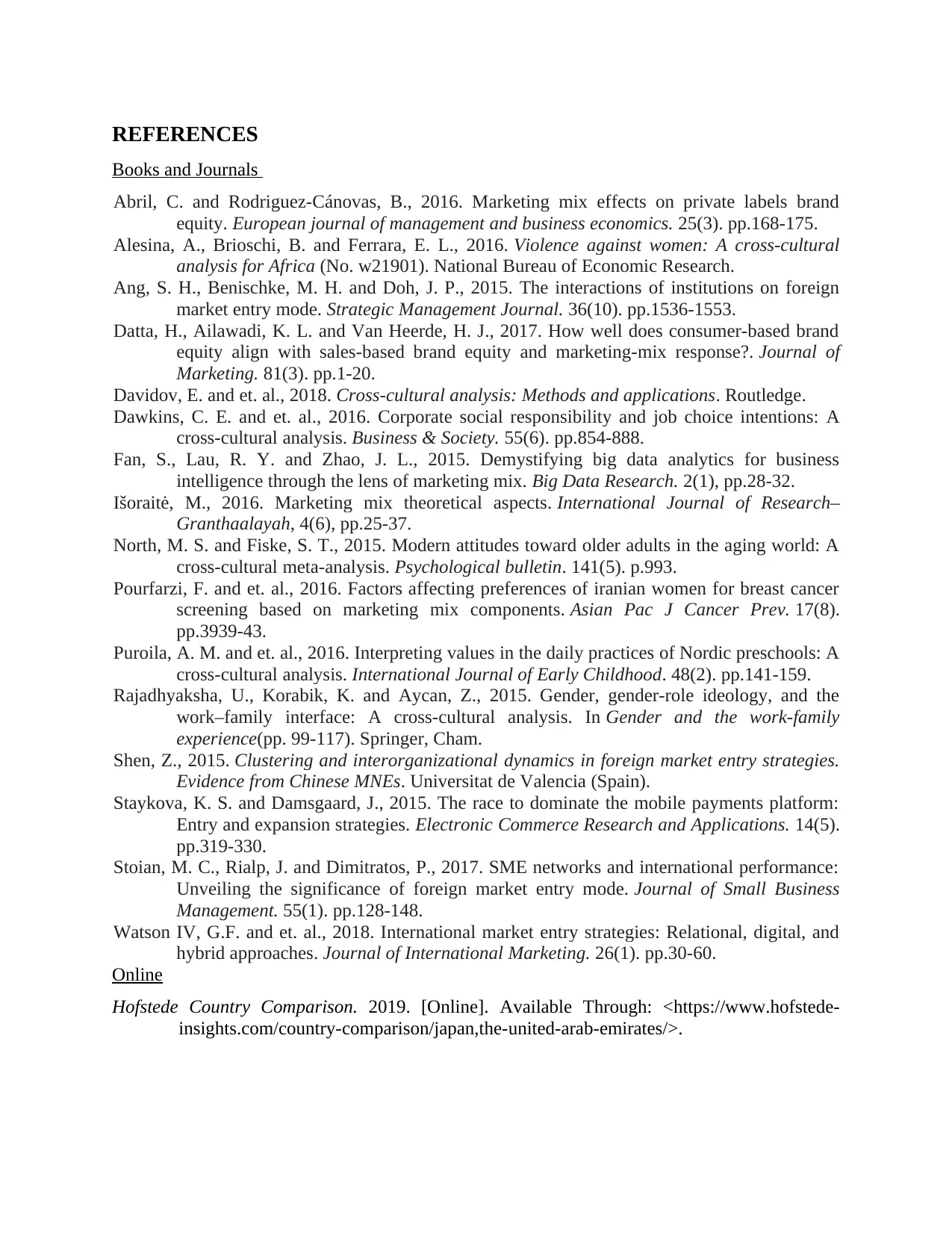
REFERENCES
Books and Journals
Abril, C. and Rodriguez-Cánovas, B., 2016. Marketing mix effects on private labels brand
equity. European journal of management and business economics. 25(3). pp.168-175.
Alesina, A., Brioschi, B. and Ferrara, E. L., 2016. Violence against women: A cross-cultural
analysis for Africa (No. w21901). National Bureau of Economic Research.
Ang, S. H., Benischke, M. H. and Doh, J. P., 2015. The interactions of institutions on foreign
market entry mode. Strategic Management Journal. 36(10). pp.1536-1553.
Datta, H., Ailawadi, K. L. and Van Heerde, H. J., 2017. How well does consumer-based brand
equity align with sales-based brand equity and marketing-mix response?. Journal of
Marketing. 81(3). pp.1-20.
Davidov, E. and et. al., 2018. Cross-cultural analysis: Methods and applications. Routledge.
Dawkins, C. E. and et. al., 2016. Corporate social responsibility and job choice intentions: A
cross-cultural analysis. Business & Society. 55(6). pp.854-888.
Fan, S., Lau, R. Y. and Zhao, J. L., 2015. Demystifying big data analytics for business
intelligence through the lens of marketing mix. Big Data Research. 2(1), pp.28-32.
Išoraitė, M., 2016. Marketing mix theoretical aspects. International Journal of Research–
Granthaalayah, 4(6), pp.25-37.
North, M. S. and Fiske, S. T., 2015. Modern attitudes toward older adults in the aging world: A
cross-cultural meta-analysis. Psychological bulletin. 141(5). p.993.
Pourfarzi, F. and et. al., 2016. Factors affecting preferences of iranian women for breast cancer
screening based on marketing mix components. Asian Pac J Cancer Prev. 17(8).
pp.3939-43.
Puroila, A. M. and et. al., 2016. Interpreting values in the daily practices of Nordic preschools: A
cross-cultural analysis. International Journal of Early Childhood. 48(2). pp.141-159.
Rajadhyaksha, U., Korabik, K. and Aycan, Z., 2015. Gender, gender-role ideology, and the
work–family interface: A cross-cultural analysis. In Gender and the work-family
experience(pp. 99-117). Springer, Cham.
Shen, Z., 2015. Clustering and interorganizational dynamics in foreign market entry strategies.
Evidence from Chinese MNEs. Universitat de Valencia (Spain).
Staykova, K. S. and Damsgaard, J., 2015. The race to dominate the mobile payments platform:
Entry and expansion strategies. Electronic Commerce Research and Applications. 14(5).
pp.319-330.
Stoian, M. C., Rialp, J. and Dimitratos, P., 2017. SME networks and international performance:
Unveiling the significance of foreign market entry mode. Journal of Small Business
Management. 55(1). pp.128-148.
Watson IV, G.F. and et. al., 2018. International market entry strategies: Relational, digital, and
hybrid approaches. Journal of International Marketing. 26(1). pp.30-60.
Online
Hofstede Country Comparison. 2019. [Online]. Available Through: <https://www.hofstede-
insights.com/country-comparison/japan,the-united-arab-emirates/>.
Books and Journals
Abril, C. and Rodriguez-Cánovas, B., 2016. Marketing mix effects on private labels brand
equity. European journal of management and business economics. 25(3). pp.168-175.
Alesina, A., Brioschi, B. and Ferrara, E. L., 2016. Violence against women: A cross-cultural
analysis for Africa (No. w21901). National Bureau of Economic Research.
Ang, S. H., Benischke, M. H. and Doh, J. P., 2015. The interactions of institutions on foreign
market entry mode. Strategic Management Journal. 36(10). pp.1536-1553.
Datta, H., Ailawadi, K. L. and Van Heerde, H. J., 2017. How well does consumer-based brand
equity align with sales-based brand equity and marketing-mix response?. Journal of
Marketing. 81(3). pp.1-20.
Davidov, E. and et. al., 2018. Cross-cultural analysis: Methods and applications. Routledge.
Dawkins, C. E. and et. al., 2016. Corporate social responsibility and job choice intentions: A
cross-cultural analysis. Business & Society. 55(6). pp.854-888.
Fan, S., Lau, R. Y. and Zhao, J. L., 2015. Demystifying big data analytics for business
intelligence through the lens of marketing mix. Big Data Research. 2(1), pp.28-32.
Išoraitė, M., 2016. Marketing mix theoretical aspects. International Journal of Research–
Granthaalayah, 4(6), pp.25-37.
North, M. S. and Fiske, S. T., 2015. Modern attitudes toward older adults in the aging world: A
cross-cultural meta-analysis. Psychological bulletin. 141(5). p.993.
Pourfarzi, F. and et. al., 2016. Factors affecting preferences of iranian women for breast cancer
screening based on marketing mix components. Asian Pac J Cancer Prev. 17(8).
pp.3939-43.
Puroila, A. M. and et. al., 2016. Interpreting values in the daily practices of Nordic preschools: A
cross-cultural analysis. International Journal of Early Childhood. 48(2). pp.141-159.
Rajadhyaksha, U., Korabik, K. and Aycan, Z., 2015. Gender, gender-role ideology, and the
work–family interface: A cross-cultural analysis. In Gender and the work-family
experience(pp. 99-117). Springer, Cham.
Shen, Z., 2015. Clustering and interorganizational dynamics in foreign market entry strategies.
Evidence from Chinese MNEs. Universitat de Valencia (Spain).
Staykova, K. S. and Damsgaard, J., 2015. The race to dominate the mobile payments platform:
Entry and expansion strategies. Electronic Commerce Research and Applications. 14(5).
pp.319-330.
Stoian, M. C., Rialp, J. and Dimitratos, P., 2017. SME networks and international performance:
Unveiling the significance of foreign market entry mode. Journal of Small Business
Management. 55(1). pp.128-148.
Watson IV, G.F. and et. al., 2018. International market entry strategies: Relational, digital, and
hybrid approaches. Journal of International Marketing. 26(1). pp.30-60.
Online
Hofstede Country Comparison. 2019. [Online]. Available Through: <https://www.hofstede-
insights.com/country-comparison/japan,the-united-arab-emirates/>.
⊘ This is a preview!⊘
Do you want full access?
Subscribe today to unlock all pages.

Trusted by 1+ million students worldwide
1 out of 12
Related Documents
Your All-in-One AI-Powered Toolkit for Academic Success.
+13062052269
info@desklib.com
Available 24*7 on WhatsApp / Email
![[object Object]](/_next/static/media/star-bottom.7253800d.svg)
Unlock your academic potential
Copyright © 2020–2025 A2Z Services. All Rights Reserved. Developed and managed by ZUCOL.





